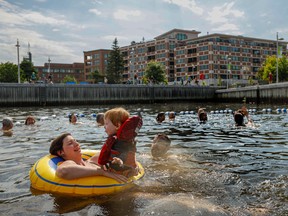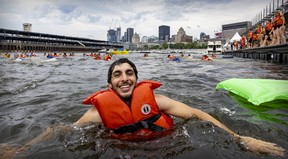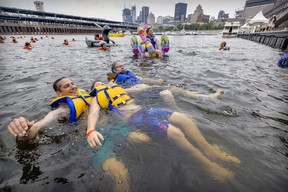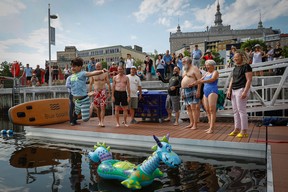Rising water levels cause erosion, landslides and other landscape changes at unprecedented rates, so expert reports calling for climate change response Is ignored.

Quebec City will launch a new "Harbor Bus" on July 1st. Was opened. Approximately 30 years after swimming enthusiasts began to be upset for safe and public access to the waters of the state capital, the St. Lawrence River.
Surrounded by a floating dock, the new harbor bus called "Oasis Duport de Quebec" is the size of an Olympic pool with five cable-separated swimming lanes. .. Eventually, a floating pool for children and a 625 square meter "relaxation zone" for those who don't want to swim long will be added. Harbor buses are popular in Europe, but oasis is the first in North America.
The new facility is good news for those who are worried about the future of the St. Lawrence River. And experts say there is a serious cause of concern.
In March 2020, a pandemic news dominated the media, and a group of more than 80 experts quietly released a report calling themselves the Great Lakes and St. Lawrence Collaborative . Announced. Encourage the federal government to invest $ 1 billion over the next decade to protect the St. Lawrence River from the effects of climate change and toxic substances.
More than 60% of Quebec live along the coast of the St. Lawrence River system, which drains more than 25% of the world's freshwater reserves. Therefore, you will think that the report called Action Plan 2020-2030 for the Future of St. Lawrence has made waves.
However, due to the timing of its release, it was largely ignored and no substantial funding was invested in the 12 major recommendations in the final federal budget. Among the river threats outlined in the report are repeated more frequent floods, coastal erosion, toxic algae outbreaks, and bacteriological pollution from untreated wastewater and agricultural spills.
Not all of these threats are caused by climate change, but they are all caused by human activity. Climate change only exacerbates the impact on river-dependent people, animals, birds, fish and plants. Survival.
One of the key recommendations of the plan is for governments and municipalities to open new beaches and other types of public access points along the banks of the St. Lawrence River. It was to provide more and better public access to the St. Lawrence River. Access is the key to getting people to care about the river, says Aurélie Sierra, an environmental sociologist who sat in one of several thematic roundtables of experts consulted to develop an action plan. increase.
"Improved and maintained access to St. Lawrence raises awareness as it is a way to approach and create attributional connections and can create a desire to protect the river. It's a great way to do this, "says Sierra, a consulting firm Atelier Social helping organizations and governments adapt to climate change.

Another important recommendation for this plan is wastewater in the coastline community. It's about improving treatment and introducing regular states. -State-of-the-art water quality monitoring programs in existing and potential swimming areas along rivers. Recent tests have shown that the water in Basin Louise, Quebec City, where the new harbor baths are located, is always clean enough to swim. But that's not the case along the river.
"There are more beaches on the shores of the Great Lakes than the St. Lawrence River, and Ontario has been in place for years of regulation, but Quebec has beach management and quality. There is no regulatory framework. " Expert follow-up report published in June 2020.
Since 1999, the state government has investigated bacteriological water quality at 48 sites between Montreal and Ile d'Orleans, adding beaches and swimming docks along the river. I've been monitoring the possibilities. Some of these places were historic beaches that were closed in the last century due to pollution. Some are currently in use and some were chosen because of their aesthetics and high potential for public access.
Since 2003, 16 "sentinel sites" have been monitored almost every summer, and according to the latest updates, most of these sites are "good" or safe swimming "good" on average. Between 2017 and 2019 it had the potential to be "very good".
However, water quality varies greatly from site to site. Based on E. coli concentration, 4 sites were rated "good" (21-100 colony forming units per 100 ml of water), 7 were "normal" (101-200 CFU / 100 ml), and 4 were rated "good". I did. "Insufficient" (above 200 CFU / 100 ml, contact with water is considered unsafe above that). Only one site has been rated "Excellent" (0 to 20). It is l’ Île Charron Park in Longueuil. Needless to say, the location is upstream of drainage from the eastern tip of Montreal.
Montreal's $ 700 million ozone treatment wastewater treatment plant, scheduled to open in December 2024, should greatly help improve water quality along Saint-Laurent. Bacteriological contamination increases just downstream of the Montreal region, and studies show that bacterial plumes from downtown Montreal are still perceptible at the exit of Lac Saint-Pierre in Trois Rivieres. If ozone treatment technology works as promised, water downstream of Montreal should be significantly cleaner after 2025. However, other municipalities need to invest in wastewater treatment and other measures to reduce the amount of raw sewage that flows into rivers when heavy rains create sewerage. Overflow. And more needs to be done to reduce pollution from agricultural spills, the report said.
"In climate change situations, the number of extreme rainfall events is expected to increase, and higher temperatures will undoubtedly make Quebec people want to cool down in swimming. The latest update from the St. Lawrence Monitoring Program concludes.
However, water quality is just one of the issues that experts are concerned about the future of the St. Lawrence River system. Rising water levels are causing erosion, landslides and other landscape changes at unprecedented rates.

"We need to be psychologically prepared for the upcoming changes ... to loss Be prepared, "says Sierra. "Yes, there is some kind of sadness as the water rises and the erosion cuts into the land."
Therefore, the Quebecites cherish the river and the river The waterfront is changing as it begins to demand better access to.
“Even in Montreal, access to rivers is very important for creating beaches and other types of access points while respecting the ecosystem,” says Sierra.
"Still, we need to be prepared for the fact that there is a lot of erosion. The level of St. Lawrence has risen significantly. Obviously, we will continue to do so for the next few years, so be flexible. You need to be prepared to respond. This means that we will provide ourselves with some access points and those access points may disappear, so we will create other access points. Must be ready. "
Sierra is in the fact that climate change is already here and changes in the physical environment are now unavoidable, if not completely predictable. People say they have to be careful.
"We work with people from an adaptive perspective to accustom them to the fact that their environment, their swimming places, their walking places, everything changes. We have to cooperate .... The swimming area we have known for many years, which has always been the same, will (inevitably) disappear in the future. For example, Oka Beach will obviously disappear. The water goes up and there is no more (beach), "she said.
For example, scientists have not specified when Oka Beach may disappear, but when accepting that rising water levels will have a dramatic impact on Quebec's waterways and coastlines. Came. The landslide in Saguenay last month and the recent floods in Ontario and Quebec are just the beginning.
"We always talk about future climate change, but the reality is that it is now," Sierra said. "It's not going to start within 10 years. We're in it and the impact is here. We see it in these floods.It's very clear. Episodes of these floods are becoming more frequent and more intense. Towns like Rigo and Gatineau have experienced it in a very violent way over the past few years.

This is not surprising to climate scientists. A 2015 study by Ouranos, a Quebec-based consortium on adaptation to climate change, found that more than 5,400 buildings (mainly residential) in the lower St. Lawrence River, Côte-Nord, Gaspesy and Lesil de la Madeleine eroded the coast. Was predicted to be destroyed by. 2065 if adaptation measures are not implemented. Almost 300 kilometers of roads and 26 kilometers of railroads disappeared, with an estimated economic loss of $ 1.5 billion at the time.
The COVID-19 crisis has made the public aware of the importance of protecting natural space, according to the nonprofit Stratégies Saint-Laurent. Director Jean-Éric Turcotte says. Coordinate local efforts to protect the river.
"I feel that St. Lawrence has become more and more central to the public's consciousness, not only since COVID, but in the last decade, and that's great. More people are mobilizing and participating .... We feel good momentum at this point in terms of the feeling of belonging to St. Lawrence and the general nature. "
Turcots and others want the public to help increase the number of riverside beaches and access points and encourage the government to invest in river conservation. And water facilities like Quebec City's Harbor Bus may be our best bet in this changing landscape.
mlalonde @ postmedia. com
-

Updates Three projects in the Montreal region that provide public access to the river
-

Environmental groups and swimmers want more beaches Swimming docks around the island of Montreal
-

Quebec has an updated map outlining the flood-risk zones Released

Daily headline news from Montreal Gazette, a division of Postmedia Network Inc. Sign up to receive it. By clicking the
Thank you for registering.
A welcome email has been sent. If you don't see it, check your junk folder.
The next issue of Montreal GazetteHeadlineNews will soon arrive in your inbox.


